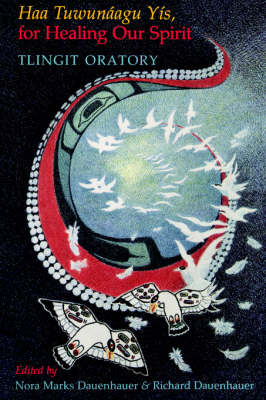Classics of Tlingit Oral Literature
1 primary work • 3 total works
Book 1
These gripping and powerful prose narratives relate monumental events in the lives of the forebears of Tlingit clans, from the prehistoric migration to the coast of Southeast Alaska to the first contact with Europeans. The stories were recorded from the 1960s to the present by twelve tradition bearers who where passing down for future generations the accounts of haa shuka, which means "our ancestors." Their narratives tell of the origin of social and spiritual concepts and explain the complex relationships among members of a given clan to their relatives in other clans, to spirits of the land where the vents took place, to the spirits of departed ancestors, and to the spirits of various animals, including killer whale and bear.
The focus here is on the stories and story tellers themselves, who lived amazingly different lives, reflecting in a small way the complexity of Tlingit life in the twentieth century, a period characterized by unprecedented political, economic, and social change. The stories were told in Tlingit and then transcribed from the tape recorded versions. The editors have attempted to write these stories the way they were told, and to then translate them into English keeping the unique Tlingit oral style.
This book will be of interest to the general reader of Native American literature and comparative literature, as well as to folklorists, linguists, and anthropologists. Of special interest to linguist will be the new texts (transcribed in three different Tlingit dialects) containing many hitherto unattested grammatical forms.
This book is an introduction to Tlingit social and political history. Each biography is compelling in its own merit, but when all are taken together, the collection shows patterns of interaction among people and communities of today, and across the generations. By combining historical documents and photographs with accounts gathered from living memory, the book also enables the present, living generations to interact with their past.
The book features biographies and life histories of more than 50 men and women, most born between 1880 and 1910, including a special section on the founders of the Alaska Native Brotherhood. Additional lives are described tangentially.
Each biography or life history follows a standard format that includes vital statistics, genealogical information, names in Tlingit and English, and major achievements. But each is also unique. Like the lives they describe, all vary in length, detail, and style, depending on authorship and available human and archival resources. To the fullest extent possible oral and written material from the subjects and their families has been incorporated. Some is more anecdotal, some historical. The appendixes include previously unpublished historical documents and Tlingit texts with facing translations.
The lives in this volume show how individual people both shaped and were shaped by their time and place in history.
Haa Tuwunáagu Yís, for Healing Our Spirit
by Nora Marks Dauenhauer and Richard Dauenhauer
Haa Tuwunaagu Yis, for Healing Our Spirit is the first publication of Tlingit oratory recorded in performance. It features Tlingit texts with facing English translations and detailed annotations; photographs of the orators and the settings in which the speeches were delivered; and biographies of the elders. There are thirty-two speeches by twenty-one Tlingit elders. Most were taped between 1968 and 1988, but two speeches were recorded on wax cylinders by the Harriman Expedition in Sitka in 1899, and are the oldest known sound recordings of Tlingit.
The book is of importance both to native and non-native readers alike. For those of Native American heritage it articulates concepts understood and practiced by elders but difficult for them to explain, and often bewildering to younger generations. For people around the world interested in Northwest Coast culture, it offers new insights into a traditional world view and the classics of Tlingit oral literature.
Careful attention is given to transcription, translation, and annotation by the collaboration of Nora Marks Dauenhauer, a native speaker of Tlingit and a published poet, with a degree in anthropology, and her husband Richard Dauenhauer, a translator of European poetry and a former poet laureate of Alaska, with a Ph. D. in comparative literature.


